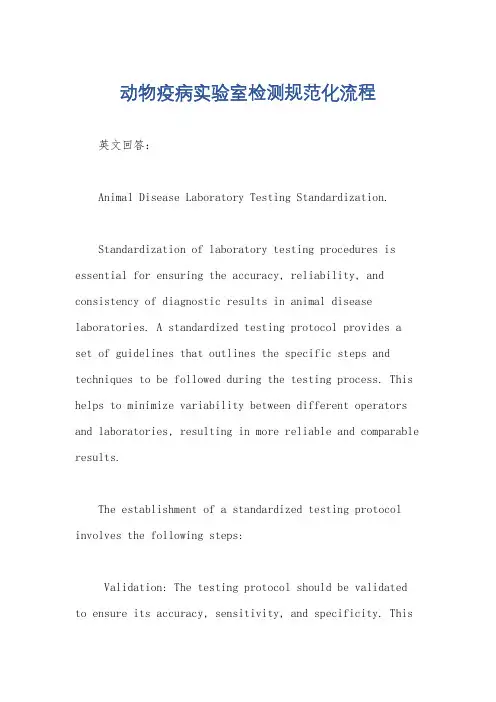动物疫病实验室检测规范化流程培训课件
- 格式:ppt
- 大小:249.00 KB
- 文档页数:12




动物疫病实验室检测规范化流程英文回答:Animal Disease Laboratory Testing Standardization.Standardization of laboratory testing procedures is essential for ensuring the accuracy, reliability, and consistency of diagnostic results in animal disease laboratories. A standardized testing protocol provides a set of guidelines that outlines the specific steps and techniques to be followed during the testing process. This helps to minimize variability between different operators and laboratories, resulting in more reliable and comparable results.The establishment of a standardized testing protocol involves the following steps:Validation: The testing protocol should be validated to ensure its accuracy, sensitivity, and specificity. Thisinvolves testing a known sample with the protocol and comparing the results to a reference standard.Documentation: The standardized testing protocol should be documented in detail. This includes describing the equipment, reagents, and procedures used, as well as the interpretation of results.Training: Laboratory personnel should be trained on the standardized testing protocol to ensure that they are following the procedures correctly.Quality control: A system for quality control should be implemented to monitor the performance of the standardized testing protocol and ensure that it is consistently producing reliable results.The benefits of using a standardized testing protocol in animal disease laboratories include:Improved accuracy and reliability of results: By following a standardized protocol, laboratories canminimize variability between different operators and laboratories, resulting in more accurate and reliable diagnostic results.Enhanced comparability of results: When different laboratories use the same standardized protocol, they can be confident that their results are comparable, allowingfor more effective disease surveillance and outbreak investigations.Increased efficiency and cost-effectiveness: Standardized testing protocols can help to increase efficiency and cost-effectiveness in the laboratory by reducing the need for duplicate testing and by streamlining the testing process.Improved communication and collaboration: Standardized testing protocols provide a common language for communication between laboratories, facilitating the sharing of information and collaboration on disease investigations.In addition to the steps outlined above, the following considerations are important for the successful implementation of standardized testing protocols in animal disease laboratories:Collaboration: Standardization efforts should involve collaboration between different laboratories, regulatory agencies, and professional organizations.Flexibility: Standardized protocols should be flexible enough to accommodate minor variations in equipment and reagents, as well as to allow for the incorporation of new technologies and advances in diagnostic methods.Continuous improvement: Standardized testing protocols should be reviewed and updated regularly to ensure that they remain current and effective.中文回答:动物疫病实验室检测规范化流程。






